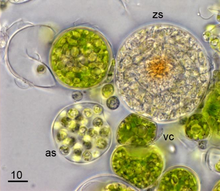Chrompodellid
| Chrompodellids | |
|---|---|

| |
| Typical life cycle stages of Vitrella brassicaformis , a chromerid (vc: vegetative cell, zs: zoosporangium, as: autosporangium)
| |
| Scientific classification | |
| Domain: | Eukaryota |
| Clade: | Diaphoretickes |
| Clade: | SAR |
| Clade: | Alveolata |
| Phylum: | Myzozoa |
| Class: | Chromeridophyceae Molinari & Guiry 2023[3] |
| Subclass: | Chromeridophycidae Mylnikov et al. 2000[4] |
| Order: | Colpodellales Cavalier-Smith 1993[1] emend. Adl et al. 2005, 2019[2][3] |
| Type genus | |
| Colpodella Cienkowsky 1865[1]
| |
| Families[2][3] | |
| |
| Synonyms | |
Chrompodellids are a
Description and life cycle
Chrompodellids are a
Colpodellids
Colpodellids, represented by the genera
Some species, considered
Chromerids
Chromerids, represented by the genera
The two genera are markedly different from each other, both in
Vitrella autospores, by contrast, start measuring 3 μm and grow up to 40 μm before transforming into sporangia that generate dozens of autospores or zoospores. There are two types of Vitrella zoospores: one is generated by budding from the mother cell and exhibits flagella outside the cytoplasm, the other develops axonemes and flagella within their cytoplasm and are ejected from the mother cell after maturing, though both types lack a pseudo-conoid. Some zoospores fuse, possibly representing a sexual stage in the life cycle.[8] In addition, Vitrella produces vaucheriaxanthin.[13]
Evolution
Chrompodellids are the closest living relatives of the
Alveolata
|
| |||||||||||||||||||||||||||||||||||||||||||||||||||
Systematics
Taxonomic history
In 1993, protozoologist
The first chromerid alga,
Between 2004 and 2017, Cavalier-Smith retained the classification scheme of Apicomonadea, from which he excluded Perkinsida, leaving only colpodellids and chromerids across multiple orders. In addition, several genera of
The treatment of chrompodellids as a subgroup of
Classification
As of 2023, chrompodellids are divided into four families and seven genera:[2][3]
- Family Alphamonaceae Adl et al. 2019[2]
- AlphamonasA.G.Alexeieff
- Family Chromeraceae Oborník & J.Lukeš 2011[21]
- Family Colpodellaceae A.G.B.Simpson & D.J.Patterson
- Family Vitrellaceae Oborník & J.Lukeš 2012[13]
- Vitrella Oborník & J.Lukeš 2012
- Incertae sedis: Piridium Patten 1936[23] (sister group to Vitrella[16][24] but not formalized as a member of Vitrellaceae)
References
- ^ Wikidata Q24634634.
- ^ Wikidata Q57086550.
- ^ a b c d e f Eduardo A. Molinari-Novoa; Michael D. Guiry (30 October 2023). "Nomenclatural notes on algae. VIII. Automatically typified names for some groups of alveolates" (PDF). Notulae Algarum. 2023 (304): 1–3.
- ^ A.P. Mylnikov; M.V. Krylov; A.O. Frolov (2000). "Таксономический ранг и место в системе протистов Colpodellida" Taksonomicheskiy rang i mesto v sisteme protistov Colpodellida [Taxonomic rank and place of Colpodellida in a system] (PDF). Parazitologiya (in Russian). 34 (1): 3–15.
- ^ Wikidata Q47194626.
- ^ S2CID 28005870.
- ^ Wikidata Q124684077.
- ^ Wikidata Q57761541.
- ^ Wikidata Q82839650.
- Wikidata Q124751768.
- Wikidata Q124744550.
- ^ a b c Jan Michálek (2020). Genomes of Chromerid Algae (PDF) (PhD thesis). Czech Republic: University of South Bohemia in České Budějovice.
- ^ PMID 22055836.
- PMID 26175406.
- ^ Wikidata Q30662251.
- ^ Wikidata Q124684358.
- Wikidata Q34167276.
- Wikidata Q28657955.)
{{cite journal}}: CS1 maint: unflagged free DOI (link - PMID 34361866.
- ^ Wikidata Q54540793.
- Wikidata Q34126892.
- S2CID 84323025.
- Wikidata Q54495349.
- Wikidata Q83229299.)
{{cite journal}}: CS1 maint: unflagged free DOI (link
